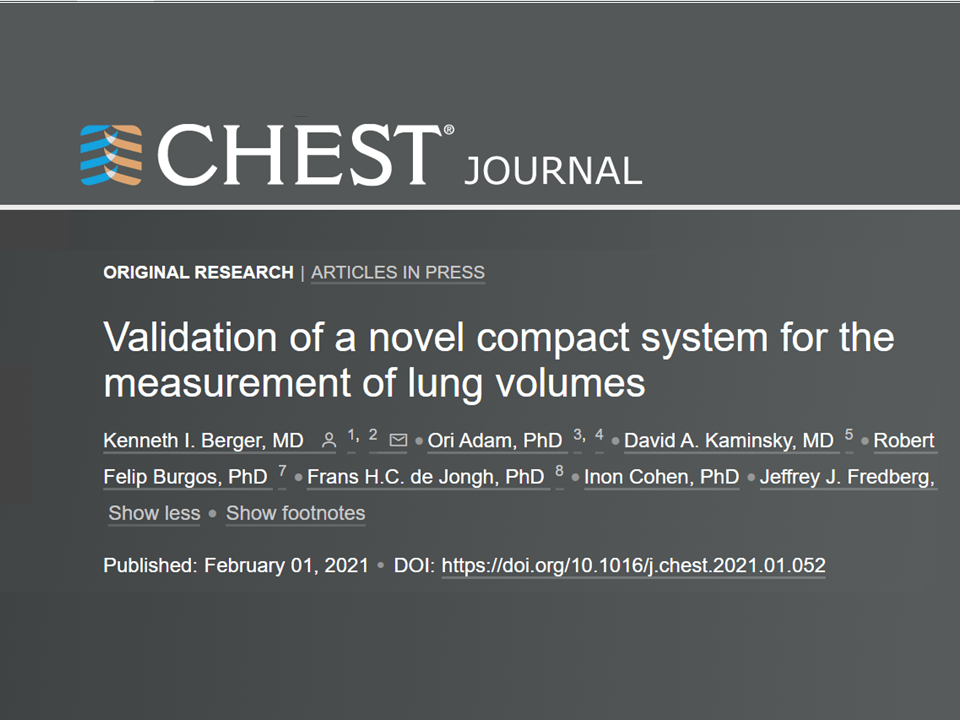MiniBox+ Lung Volumes Shown to be Equivalent to Body Box in Multi-center Study

In a groundbreaking, multi-center study just published in CHEST, lung volumes measured with the MiniBox+™ were shown to be equivalent to body plethysmography (“body box”) in both healthy participants as well as those with lung disease. MiniBox+ lung volumes were more reproducible and correlated better with body plethysmography than the other leading office-based techniques.
The study
A systematic, multi-center study compared total lung capacity (TLC) measured by body plethysmography (TLCPleth) with TLC measured by the MiniBox+ (TLCMB). Collaborating researchers from 5 medical centers in the US and Europe contributed comparative data from 266 participants – 197 with obstructive disorders, 33 with restrictive disorders, and 36 healthy.
For robustness, several body plethysmograph devices were used in the study, manufactured by Medisoft, MGC Diagnostics, and Vyaire. All measurements conformed with ATS/ERS guidelines.
The results
The normalized standard deviation (NSD) between the TLCPleth and TLCMB was 7.0% in healthy participants. For patients with obstructive disease, the NSD ranged from 7.7 to 9.1% depending on disease severity. For patients with restrictive disease, the overall NSD was 10.3%. In all groups there was no significant difference between the measurements taken by the MiniBox+ vs. the body box.
In 14 cases in this study, the patient’s final clinical diagnosis differed by device. In 10 of these cases, the final diagnosis correlated better with the physiologic pattern characterized by the TLCMB than by TLCPleth.
The 5 options for measuring lung volumes
Five methods are currently recommended by ATS/ERS for measuring lung volumes: whole body plethysmography, multi-breath helium dilution (He), nitrogen wash-out (N2), computerized tomography (CT), and chest radiography (CXR). Each of these techniques has pros and cons to the clinical user and the patient. For example, CT and CXR are not utilized in PFT labs and incur radiation exposure, while He and N2 may underestimate lung volumes, as gas may not fully distribute to poorly ventilated areas.
Why plethysmography is the gold standard
The choice of technique depends on availability, cost, convenience and accuracy. Each of the existing methods is capital intensive and technically challenging, requiring a skilled technician for calibration, operation and maintenance. Of these however, body plethysmography requires less time to demonstrate repeatability between measurements, especially in patients with obstructive airway diseases.
MiniBox+ lung volumes correlate better with the body box than other office-based methods
In this study, TLC measurements taken with the MiniBox+ correlated more favorably with the body box than measurements taken with helium dilution and nitrogen washout in other comparative studies.
Mean Normalized Standard Difference (NSD)
| % | # published studies | |
| Helium Dilution | 15.3 | 6 |
| Nitrogen washout | 14.2 | 1 |
| Computerized Tomography | 13.1 | 4 |
| MiniBox+ | 8.9 | 1 |
Why the MiniBox+ outdoes the body box on a practical level
The body box can be intimidating and uncomfortable for the patient enclosed within it. Testing requires complex respiratory maneuvers, which can be particularly exhausting for obstructed patients. In contrast, the MiniBox+ measures lung volumes using normal breathing. In addition, as a desktop device, the MiniBox+ is less costly, mobile, and simpler to operate and disinfect when compared to other lung volume measurement systems.
The authors’ conclusions
In light of the data in the present study, the authors state that the MiniBox+ should be considered equivalent to plethysmography for measurement of lung volumes in clinical practice.
Download our Info Kit now to learn more about the MiniBox+
